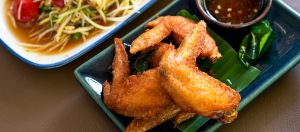My favorite Peruvian dish (lomo saltado, a stir-fried dish of beef, french fries, onion, and peppers) uses soy sauce for its flavor base. A full 5% of the Peruvian population is Asian. And, according to one source, as many 5 million Peruvians have some Chinese ancestry, which equates to 20% of the country’s total population. Peru isn’t unique. All of the Latin American countries have sizeable Asian populations. Brazil has the largest asian population of any Latin American country. It has a large Chinese enclave, a quarter million strong. It has an even larger Japanese population of 1.7 million. Today, there are more than four million Asian Latin Americans, composing nearly 1% of Latin America’s total population.
That segment is growing in the United States as well. According to OkCupid’s internal data, while men of all other racial groups preferred Asian women, Asian men preferred Latinas. Asian men responded more to single Latina women than to women of any other ethnicity, marking themselves “interested” 19% of the time.
In the 2010 US Census, almost 600,000 Americans identified as both Asian and either Hispanic or Latino. Yet, in the United States, Asian Latin Americans are a nearly invisible segment of society. These tri-cultural Americans are often called “Chinos” (like the pants) or “Chinas” (pronounced chee-nahs) by their Hispanic peers, sometimes lovingly, and sometimes derisively. Being tri-cultural, they often have difficulty fitting into their local Asian communities, which tend to ostracize cultural outsiders. To use Michelle Yeoh’s terminology from Crazy Rich Asians, most Asians do not consider Asian Latin Americans “our kind of people.” They don’t fit into the Latinx community either, as their Asian-ness make them “other.”
But there are more similarities than differences. In the States, both the Asian community and Latinx community grew up side by side, often in the same parts of America’s many cities. They share the same family values, the same love of food, and the same love of sappy pop music.
Both cultures are family centric and often live in multi-generational households. Both sets of peoples came to the United States with the dream of a better life and the elief that pure elbow grease would pave the way for their children. Both are tech-savvy as they seek to connect with family and friends back at home.
Both cultures also express their love through their wide variety of food and rich flavor profiles. The most famous food crossover started in Los Angeles—the Kogi Food Truck empire. Kogi Korean BBQ is a fleet of five fusion food trucks in Los Angeles famous for its combination of Korean with Mexican food. Instead carne asada and jalapeno, Kogi’s taco shells are filled with Korean bulgogi and Kimchi. Kogi’s genius combination inspired a whole bunch of Asian Hispanic fusion eateries throughout the country.
Both Latinx and Asians love their pop music. We previously discussed how K-pop’s biggest growth was among Hispanics. Not only have K-pop bands started to sing in Spanish, there have also been collaborations between Mexican and Korean pop bands. In Oct 2018, Super Junior and REIK released a mashup MV called “One More Time”. With 50 million views and 1.5 million likes, it is evidence to the beautiful blend of Hispanicity and Asianess.
As the two fastest growing segments in the U.S., Hispanics and Asian Americans are weaving their cultural threads together into the larger American fabric. Their entwinement creates an ever-growing tri-cultural population that identifies as both American, Asian, and Latinx.







